|
Antiques
|
|
 |
|
 |
|
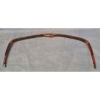
Price :
Contact Dealer
SOLD Antique 17th-18th century Islamic Composite War Bow Turkish Ottoman or Indo Persian. Of characteristic form with a rounded hand grip, painted on the exterior and More »
SOLD Antique 17th-18th century Islamic Composite War Bow Turkish Ottoman or Indo Persian. Of characteristic form with a rounded hand grip, painted on the exterior and interior in black and red, bordered with gold bands, and adorned with painted in gold and green shaped panels.
The process to make a composite bow was very long and complicated, different horn was used, wood, and sinew, and a correct balance between these different components provided a highly efficient bow, therefore composite bows were very expensive compared to other weapons. The composite bows were a powerful weapon of the Islamic, Tatar and Eastern European armies. These types of bows were made in Turkey and Persia from the 15th to the 18th century. Since bows were very expensive and would not go out of fashion or style, they were passed from father to son and were used by the next generations, so bows made in the 17th century were still used during the 18th century.
CONDITION: The bow is in its original condition, chips in the lacquer surface, some losses to the paint, one edge is slightly split.
Overall length: 77 .5 cm (30 1/2 in).
REFERENCES: A similar bows are published in the book: “TÜRK OKÇULUĞU†(Ataturk Kultur Merkezi yayn) (Turkish Edition).Illustrations 150,151,152.
We do not want to make a judgment if the bow is Turkish or Indo Persian, however we provide our clients with a certificate of authenticity to ensure that the bow is 100% authentic antique made in the 17th-18th century.
There are three layers in the composite bows: sinew on the back (the side under tension), wood for the core and horn on the belly (the compression side facing the archer). Turkish and Indo Persian bowyers purchased green wood or bamboo. The parts were shaped and reflexed as needed, seasoned for about a year, fitted, joined with glue and dried for another year. Pre-shaped horn strips were glued onto the belly of a bow. Both wood and horn were scored with a special toothed tool and glued together (clamping was achieved by tight binding with rope). Matching pairs of water buffalo horns were used almost exclusively, with an exception of longhorn cattle horns for some Turkish bows. Cattle horns had to be boiled heated and pressed into a correct shape in special wooden molds. Buffalo horns are also more flexible and resilient than cattle horns and provide thicker strips. It is probable that in Indo Persian bows, instead of a solid strip, many thin ones were glued together into one wider strip. The back of a bow was then covered with sinew, leaving most of the ears/tips bare. Sinew usually came from cow leg tendons, possibly neck (back) tendons. Tendons from wild animals (deer, moose etc.) must have also been used, and, in the authors opinion, are better, leaner, stronger, longer and easier to work with. The dried tendon is pounded until separated into fibers, which are sorted into bundles of similar length. The bundles are soaked in glue and laid onto the back of a bow. 2-3 layers are used for a dry thickness of approx. 3-6mm. On Turkish flight bows a ridge along the centre of siyahs was formed to increase cast. Bows were always seasoned after this last operation from 6 months to at least a year .Due to shrinkage of sinew and glue (and from deliberate, progressive reflexing betw. layers of sinew in case of Turkish) bows were at this point very strongly reflexed with tips touching or even crossed. The reflex made the tillering and stringing, which followed, a rather long and complicated operation. Glue was an important component of the bows, the amount of glue in a finished bow was almost equal to the relative amounts of sinew or horn. Only three kinds of collagen-based glues were used: fish, tendon and skin. For the fish glue, either dry skin from "the roof of the mouth" of Danube sturgeon (Turkish, other fish for Chinese) or isinglass (sturgeon air bladder, Chinese) were soaked in water and heated into solution. The Turks mixed this glue with tendon glue, made from boiled tendons. A glue of lesser quality was made from boiled skins. Such glues readily absorb moisture rendering the bows useless in relative humidity above 70%. The bows had to be stored as dry as possible, kept by the fire, in the sun, or in heated cabinets. The tillering was accomplished by gradual bending a warmed bow with minimal scraping of the horn layer to balance the arms. The arms were also given the desired curvature and/or weight by warming and tying to special wooden forms until cooled. Turkish flight bows were heated in "conditioning boxes" for 24 hours up to 4 days before competitions to thoroughly dry them (the sinew, glue and horn acquire very high strength and elasticity when very dry). Of course, the bows were never shot when warm; heat, as well as moisture, would make them weak and follow the string. The finished bows were decorated with painted and gilded ornamentation. Wooden or horn "bridges" were glued on the belly side where the ears join the siyahs/knees as supports for string loops.
ALL ITEMS ARE GUARANTEED TO BE AUTHENTIC ANTIQUES, AND NOT REPRODUCTIONS.
ALL OUR ARTIFACTS ARE ACCOMPANIED BY A CERTIFICATE OF AUTHENTICITY.
WE SHIP INTERNATIONALLY
« Less
|
|
Antique Arms and Armor
|
|
Vendor Details
|
|
| ITEM IS NO LONGER AVAILABLE |
|
|
|
| Vendor Details |
Close |
| Contact Info : |
| Hundred and One Antiques |
| Email : antiquarian101@gmail.com |
| Phone : 6139798250 |
|
|
|
|
|
|

Price :
Contact Dealer
A 19th CENTURY OTTOMAN METAL THREAD APPLIQUE BLACK, RED, AND GRREN SILK CURTAIN FOR ONE OF THE DOORS OF THE HOLY MADINA IN MECCA.
The curtain is signed by the Ottoman More »
A 19th CENTURY OTTOMAN METAL THREAD APPLIQUE BLACK, RED, AND GRREN SILK CURTAIN FOR ONE OF THE DOORS OF THE HOLY MADINA IN MECCA.
The curtain is signed by the Ottoman Sultan Mahmud II who ruled between year 1808 and year 1839.
Measure: 244 cm length and 200 cm width.
The Handmade workman-ship reflects the professional ancient Islamic art that characterized the era of Islamic Caliphate and is silk embroidered with silver and gold coloring wires.
It contains verses from the Holy Quran and decorations that reflect the old Islamic traditions and customs.
Price provided on request.
« Less
|
|
Antique Embroidery
|
|
Vendor Details
|
|
| ITEM IS NO LONGER AVAILABLE |
|
|
|
|
|
|
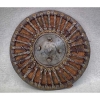
Price :
Contact Dealer
SOLD Antique 16th-18th century Turkish Ottoman steel-mounted Islamic wicker Shield Kalkan. DETAILS: Domed and of circular form composed of concentric wicker woven with More »
SOLD Antique 16th-18th century Turkish Ottoman steel-mounted Islamic wicker Shield Kalkan. DETAILS: Domed and of circular form composed of concentric wicker woven with coloured thread, the exterior made up of radial steel bars linking the steel frame, steel domed center boss with rosette and five square finials. The interior center set with wood and remains of the original red fabric lining, , leather strap, and six iron rings for suspension.
This type of wicker kalkan shield became emblematic of the Golden Age of the Ottoman Empire for the Turkish soldiery, some of these types of Islamic wicker shields were made for high rank officers as large luxurious parade shields decorated with gold and embellished with precious stones. This particular one is a typical smaller combat shield, therefore, more manoeuvrable form of a shield designed to protect the Ottoman warrior from attack by archers. The flexibility of the wicker absorbed the power of the arrow, and the swords.
Diameter: 28 cm (11 in).
CONDITION: In good condition considering its age, some minor wear to the thread.
REFERENCES: (1) Sotheby’s Arts of Islamic World London 12 October 2000. Lot167. (2) Bonhams. The Jacques Desenfans Collection. 10 April 2008
ALL ITEMS ARE GUARANTEED TO BE AUTHENTIC ANTIQUES, AND NOT REPRODUCTIONS.
ALL OUR ARTIFACTS ARE ACCOMPANIED BY A CERTIFICATE OF AUTHENTICITY.
WE SHIP INTERNATIONALLY
« Less
|
|
Antique Arms and Armor
|
|
Vendor Details
|
|
| ITEM IS NO LONGER AVAILABLE |
|
|
|
| Vendor Details |
Close |
| Contact Info : |
| Hundred and One Antiques |
| Email : antiquarian101@gmail.com |
| Phone : 6139798250 |
|
|
|
|
|
|
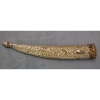
Price :
Contact Dealer
SOLD Antique 18th century Turkish Ottoman silver dagger scabbard (apparently unmarked) in the Ottoman Imperial manner, with finely chased and incised floral and vine More »
SOLD Antique 18th century Turkish Ottoman silver dagger scabbard (apparently unmarked) in the Ottoman Imperial manner, with finely chased and incised floral and vine decoration, all against a ring matted ground, and a stylized palm finial. A gold gilt silver upper mount (locket), with beaded work, set with green and red gems. These types of luxury items were made for Turkish Aristocracy in Ottoman Imperial manufactures in Istanbul during the 17th -18th century, by the best silver and goldsmiths.
CONDITION: The scabbard is in very good condition.
MEASUREMENTS: Overall length: 19.7 cm (7 3/4 in).
WEIGHT: 67grams (2 3/8 troy oz)
ALL ITEMS ARE GUARANTEED TO BE AUTHENTIC ANTIQUES, AND NOT REPRODUCTIONS.
ALL OUR ARTIFACTS ARE ACCOMPANIED BY A CERTIFICATE OF AUTHENTICITY.
WE SHIP INTERNATIONALLY
« Less
|
|
Antique Arms and Armor
|
|
Vendor Details
|
|
| ITEM IS NO LONGER AVAILABLE |
|
|
|
| Vendor Details |
Close |
| Contact Info : |
| Hundred and One Antiques |
| Email : antiquarian101@gmail.com |
| Phone : 6139798250 |
|
|
|
|
|
|
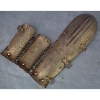
Price :
Contact Dealer
SOLD Very Rare Antique 15th-17th century Turkish Ottoman Armour Arm guard Bazuband, for the right arm, of typical early Turkish form, with twin wrist splints plates. The More »
SOLD Very Rare Antique 15th-17th century Turkish Ottoman Armour Arm guard Bazuband, for the right arm, of typical early Turkish form, with twin wrist splints plates. The outer surface engraved with floral arabesques, and inlaid in koftgari, decorated by pins with rosette finials, and set with small buckles for straps, retaining studs for lining.
CONDITION: Signs of age and usage, worn koftgari inlay, one small buckle on the wrist splint is missing, another is broken, some spots, slightly corroded, however, still in good condition considering its age.
MEASUREMENTS: Overall length: 34 cm (13 3/8 in). Width of the bazuband alone: 10.5 cm (4 1/8 in). Overall width with the wrist splints plates: 23.5 cm (9 1/4 inches).
Compared to Indo Persian Bazubands, the Turkish Ottoman Arm guards Bazubands are rarely seen, not only on the antiquarian market, but also in museums. Turkish Ottoman Arm guards Bazubands are so rare that in many museums curators display mistakenly Ottoman leg guards, as arm guard Bazubands, as they have never seen early Turkish arm guards BazuBands.
A pair of similar Ottoman steel Bazubands, but in better condition, had been sold in the Christie’s Art of the Islamic and Indian World London, on 8 April 2008, lot 181, for £23,300 ($46,181).
ALL ITEMS ARE GUARANTEED TO BE AUTHENTIC ANTIQUES, AND NOT REPRODUCTIONS.
ALL OUR ARTIFACTS ARE ACCOMPANIED BY A CERTIFICATE OF AUTHENTICITY.
WE SHIP INTERNATIONALLY
« Less
|
|
Antique Arms and Armor
|
|
Vendor Details
|
|
| ITEM IS NO LONGER AVAILABLE |
|
|
|
| Vendor Details |
Close |
| Contact Info : |
| Hundred and One Antiques |
| Email : antiquarian101@gmail.com |
| Phone : 6139798250 |
|
|
|
|
|
|
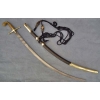
Price :
Contact Dealer
SOLD Antique 18th century Turkish Ottoman Islamic sword Shamshir. A curved single edged blade with a watered Turkish Damascus steel Wootz pattern, decorated on the outer More »
SOLD Antique 18th century Turkish Ottoman Islamic sword Shamshir. A curved single edged blade with a watered Turkish Damascus steel Wootz pattern, decorated on the outer side with four silver inlaid calligraphic cartouches with Arabic script, the other side of the blade decorated with a silver koftgari six pointed star, an Islamic secret symbol, the Seal of Solomon, comprised of calligraphic Arabic inscriptions. A hilt comprised of a grip with horn grip-scales, rising to a bulbous pommel in a characteristic Turkish Ottoman style, enclosed by brass straps, a brass crossguard with bud – shaped terminals, engraved with foliate borders. In its leather-bound wooden scabbard stitched with spiral wire, mounted with a large brass locket, with a band with two loops for suspension, a large chape, all decorated en suite with embossed and engraved foliage, with its original carrying belt with two tassels woven with silver.
CONDITION: A bulbous pommel of the horn hilt is damaged with signs of old repairs, the border for the langets on the one side of the locket is chipped, which are signs of the age and usage, which can be expected from an over 200 year old sword. This is a very good quality Turkish shamshir, and one of the best which I have seen over the years.
MEASUREMENTS: The overall length with the sword in the scabbard is approximately: 94.5 cm (37 1/4 in). The overall length without the scabbard is approximately: 93.5cm (31.5 in).
ALL ITEMS ARE GUARANTEED TO BE AUTHENTIC ANTIQUES, AND NOT REPRODUCTIONS.
ALL OUR ARTIFACTS ARE ACCOMPANIED BY A CERTIFICATE OF AUTHENTICITY.
WE SHIP INTERNATIONALLY
« Less
|
|
Antique Arms and Armor
|
|
Vendor Details
|
|
| ITEM IS NO LONGER AVAILABLE |
|
|
|
| Vendor Details |
Close |
| Contact Info : |
| Hundred and One Antiques |
| Email : antiquarian101@gmail.com |
| Phone : 6139798250 |
|
|
|
|
|
|
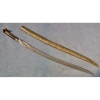
Price :
Contact Dealer
SOLD A Rare antique 18th century Rhinohorn - hilted Turkish Ottoman Islamic sword Yatagan-Yataghan. DETAILS: A rare style of hilt formed of two pieces of Rhino horn More »
SOLD A Rare antique 18th century Rhinohorn - hilted Turkish Ottoman Islamic sword Yatagan-Yataghan. DETAILS: A rare style of hilt formed of two pieces of Rhino horn scales, retained by three iron rivets, and enclosed by silver straps decorated and engraved with designs of scrolling foliage. A recurved single edged Damascus steel blade, with an extremely rare and unique Damascus steel pattern, incised with a panel with a calligraphic cartouche, with the forte applied with shaped silver facing, decorated in ensuite with straps with engraved scrolling foliage. A brass scabbard with a wooden insert, richly adorned in repousse, and engraved designs of scrolling vegetation.
Most of Yatagans have a characteristic ear shaped hilt, Yatagans with this style of hilt are very rare.
The Yatagan sword was very popular, not only in Turkey, but also in many Balkan states, and some Eastern European countries such as Ukraine and Hungry.
REFERENCES:
1) “Yanissari – History Symbols Weapons†by G.E.Vvedensky
2) “Zbirka Jatagana†by Dora Boskovic
3) “Les Armes Blanches do Monde Islamic†by Alain Jacob
4) “The Janissaries†by David Nicolle
MEASUREMENTS: The overall length in the scabbard is approximately: 85 cm (33 1/2 in). The overall length without the scabbard is approximately: 77.5 cm (30 1/2 in).
CONDITION: The silver mounting of the hilt is damaged in several places, the brass scabbard is dented in the lower part, with signs of old soldering, please refer to the attached pictures. The wooden insert of the scabbard is shrunken, which makes the scabbard very tight. These are signs of age and usage, that can be expected from an over 250 year old combat sword.
ALL ITEMS ARE GUARANTEED TO BE AUTHENTIC ANTIQUES, AND NOT REPRODUCTIONS.
ALL OUR ARTIFACTS ARE ACCOMPANIED BY A CERTIFICATE OF AUTHENTICITY.
WE SHIP INTERNATIONALLY
« Less
|
|
Antique Arms and Armor
|
|
Vendor Details
|
|
| ITEM IS NO LONGER AVAILABLE |
|
|
|
| Vendor Details |
Close |
| Contact Info : |
| Hundred and One Antiques |
| Email : antiquarian101@gmail.com |
| Phone : 6139798250 |
|
|
|
|
|
|
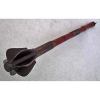
Price :
Contact Dealer
SOLD Rare antique 17th century Turkish Ottoman or Eastern European (Polish – Hungarian) horseman combat mace Buzdygan - Buzogányok with tubular iron head retained More »
SOLD Rare antique 17th century Turkish Ottoman or Eastern European (Polish – Hungarian) horseman combat mace Buzdygan - Buzogányok with tubular iron head retained by a domed cap and fitted with six shaped flanges with an integral gold inlaid steel socket, fruitwood haft retaining its original silver and brass wire bands.
REFERENCES:
1) Christie’s catalogue: "Twenty rooms: The private collection of the late Mrs. Elias-Vaes". Sale 2857. Amsterdam; 27 April 2010 - 29 April 2010. Lot 341.
Title: A HORSEMAN'S MACE, TURKISH OR EAST EUROPEAN 17TH CENTURY. Sold for €2,750
2) Thomas Del Mar Antique Arms and Armour catalogue: London ; 30th June 2010 Lot 106.
Title: TURKISH SILVER MOUNTED MACE 17TH/18TH CENTURY. Sold for 2640 GBP
The buyer will be provided with a copy of the pages from the mentioned catalogues together with a certificate of authenticity.
The Buzdygan - maces, or flanged (winged) maces, where the head of the mace is divided into the "feathers - flanges†(usually six or eight). These were used as battle weapons bared by a colonel as a symbol of rank, and a sign of the officer's authority, as the commander of the Turkish, Polish, Hungarians, Russians, and Ukrainians Cossacks, during the 16th-18th century, of many different varieties and styles. Maces used in Poland were mostly of Eastern origin. Many goods were imported from Ottoman Empire and Persia but also from the Hungary and Transylvania (both under Ottoman influences). In a turn of 17th and 18th century some Polish manufactures (especially so-called Lwow Manufacture run by Armenians, the refugees from the Persian and Ottoman empire) started to made some decorative maces using Eastern Islamic patterns.
MEASUREMENTS: Overall length: 55.5 cm (21 7/8 in). Height of the iron head including socket: 17.9 cm (7 in). Length of the flanges approximately: 8 cm (3 1/8 in).
CONDITION: In its original condition showing the age and usage with a dark patina, the gold inlay is partly worn, brass wire broken in several places and fastened by glue.
ALL ITEMS ARE GUARANTEED TO BE AUTHENTIC ANTIQUES, AND NOT REPRODUCTIONS.
ALL OUR ARTIFACTS ARE ACCOMPANIED BY A CERTIFICATE OF AUTHENTICITY.
WE SHIP INTERNATIONALLY
« Less
|
|
Militaria
|
|
Vendor Details
|
|
| ITEM IS NO LONGER AVAILABLE |
|
|
|
| Vendor Details |
Close |
| Contact Info : |
| Hundred and One Antiques |
| Email : antiquarian101@gmail.com |
| Phone : 6139798250 |
|
|
|
|
|
|
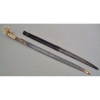
Price :
Contact Dealer
Antique early 19th century (1809) Turkish Ottoman Islamic sword yatagan with a characteristic ear shaped hilt mounted in gilded and silvered metal decorated with bands of More »
Antique early 19th century (1809) Turkish Ottoman Islamic sword yatagan with a characteristic ear shaped hilt mounted in gilded and silvered metal decorated with bands of fine filigree bead and open wire work. A single edged blade with a narrow fuller is richly ornamented with silver inlaid Arabic calligraphy and dated to 1224 in the Islamic calendar (1809 in the Gregorian calendar).
In its original leather covered wooden scabbard with an iron locket and chape.
The yatagan was the favorite sword of the Janissaries and was also very popular in many Balkan states and some Eastern European countries such as Ukraine and Hungary.
CONDITION: The grips are cracked (as common in these swords) but hold very solid, the metal grip strap slightly damaged, coral stones are missing
REFERENCES:
1) “Yanissari – History Symbols Weapons†by G.E.Vvedensky
2) “Zbirka Jatagana†by Dora Boskovic
3) “Les Armes Blanches do Monde Islamic†by Alain Jacob
4) “The Janissaries†by David Nicolle
MEASUREMENTS: The overall length in the scabbard is approximately: 78.5 cm (30 7/8 in). The overall length without the scabbard is approximately: 75.5 cm (29 3/4 in).
ALL ITEMS ARE GUARANTEED TO BE AUTHENTIC ANTIQUES, AND NOT REPRODUCTIONS.
ALL OUR ARTIFACTS ARE ACCOMPANIED BY A CERTIFICATE OF AUTHENTICITY.
WE SHIP INTERNATIONALLY
« Less
|
|
Antique Arms and Armor
|
|
Vendor Details
|
|
| ITEM IS NO LONGER AVAILABLE |
|
|
|
| Vendor Details |
Close |
| Contact Info : |
| Hundred and One Antiques |
| Email : antiquarian101@gmail.com |
| Phone : 6139798250 |
|
|
|
|
|
|

Price :
Contact Dealer
SOLD Antique 18th -19th century Turkish Ottoman or Turcoman Islamic Warrior belt made of stiff broad double sown together layers of hide, beautifully enriched at the front More »
SOLD Antique 18th -19th century Turkish Ottoman or Turcoman Islamic Warrior belt made of stiff broad double sown together layers of hide, beautifully enriched at the front with three rows of large oval Genuine Carnelians (Precious Stones) in raised beaded gild silver settings, mounted on a brass panel. The back ornamented with pierced brass plaques attached with large round-headed brass rivets. At the right side a pendant openwork brass disc set with another carnelian; at the left side the clasp in the form of another openwork brass disc with carnelian. There are three square loops for adjustment. The Belt has a total of 39 carnelians.
REFERENCES: A belt similar to this (described as the Turkmen mounted on Chain Mail armor) is published in the book "Persian and Indo-Persian Arms and Armor of 16th-19th Century from Polish Collection -Catalogue exhibition Malborg Castle Museum" by Antoni Romuald Chodinski.
The buyer will be provided with a copy of the pages from the mentioned references, together with the certificate of authenticity.
CONDITION: Shows signs of usage and wear, some brass and pewter rivets are missing, leather very dried and cracked, but holds very well. Please note that this antique is made of over 200 year old leather, which was well used, so a perfect condition cannot be expected.
DIMENSIONS: Approximately. Overall length with buckle: 132 cm (52 in).Width at the front: 10cm (3 7/8 in)
ALL ITEMS ARE GUARANTEED TO BE AUTHENTIC ANTIQUES, AND NOT REPRODUCTIONS.
ALL OUR ARTIFACTS ARE ACCOMPANIED BY A CERTIFICATE OF AUTHENTICITY.
WE SHIP INTERNATIONALLY
« Less
|
|
Antiques
|
|
Vendor Details
|
|
| ITEM IS NO LONGER AVAILABLE |
|
|
|
| Vendor Details |
Close |
| Contact Info : |
| Hundred and One Antiques |
| Email : antiquarian101@gmail.com |
| Phone : 6139798250 |
|
|
|
|
|
|
|
|

|


